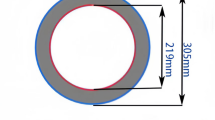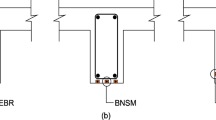Abstract
The transfer of prestress force from prestressing strands to the surrounding concrete is dependent on the bond between the two materials. Understanding the actual bond stress distribution along the transfer length results in optimized design of the transfer zone of prestressed concrete members. Equations of estimating the transfer length in ACI 318 code and AASHTO LRFD bridge design specifications simply take into account the effect of the strand diameter only. The objective of this study is to provide a generalized procedure for determining the bond stress–slip relationship accurately by incorporating the effects of additional parameters, such as concrete compressive strength at prestress release, center-to-center strand spacing, and concrete bottom cover. First, the bond stress distribution along the transfer length of a prestressed concrete member is formulated based on longitudinal slip–strain compatibility, force equilibrium and invariable bond stress–slip relationship along the transfer length. Second, a generalized Inverse Problem-Solving approach is introduced to determine best parameter coefficients through minimizing the discrepancy between the calculated and measured results. Two types of measurements (i.e., transfer length and end slip) reported in the literature are utilized to demonstrate the proposed approach. Predicted transfer length and end slip values using the calibrated bond stress–slip relationship show better agreement with the test data compared to those predicted by ACI 318 code and AASHTO LRFD bridge design specifications. Third, a computational procedure is developed and an example is presented to assist engineers using the developed formulae for determining the bond stress distribution along the transfer length of prestressed concrete members.






Similar content being viewed by others
Abbreviations
- A ps :
-
Area of a strand
- A c :
-
Area of the concrete cross-section
- A tot :
-
Total area of strands
- C tot :
-
The total circumference of all strands in a prestressed concrete member
- c bc :
-
Clear bottom cover
- d ps :
-
Diameter of a strand
- E ci :
-
Concrete elastic modulus at prestress release
- E ps :
-
Elastic modulus of strands
- f′ ci :
-
Concrete compressive strength at prestress release
- f pe :
-
Effective prestress in strands
- f pj :
-
Jacking stress in strands
- f ps.z :
-
Prestress in strands at z-coordinate location
- f pu :
-
Ultimate strength of prestressing strand
- I x :
-
Moment of inertia of the concrete cross-section
- l t :
-
Transfer length of strands
- M c.z :
-
Moment in the concrete cross-section at z-coordinate location
- M c.0 :
-
Moment in the concrete cross-section at the transfer length location
- M sw.0 :
-
Moment due to self-weight at the transfer length location
- M sw.z :
-
Moment due to self-weight at z-coordinate location
- m n,i :
-
Measured values corresponding to the measurement type n
- N :
-
Total types of measurements
- N c.z :
-
Axial force in the concrete cross-section at z-coordinate location
- N e.0 :
-
Axial force in the concrete cross-section at the transfer length location
- N ps.z :
-
Prestress force in strands at z-coordinate location
- N :
-
Measurement type
- n ps :
-
Number of strands in a member cross-section
- OF n :
-
Discrepancy of the measurement type n
- P j :
-
Jacking force in strands
- p n,i :
-
Predicted values corresponding to the measurement type n
- R tot.n :
-
Total number of records for the measurement type n
- S :
-
Slip of strand to concrete
- s z :
-
Slip of strand to concrete at z-coordinate location
- s end :
-
Slip of strand to concrete at the ends of a specimen
- s cc :
-
Center-to-center strand spacing
- w n :
-
Weighting factor for the measurement type n
- v i (i = 3, 4, …, k):
-
Other parameters except the slip and the strand diameter
- \(\overline{y}\) :
-
Distance from the centroid to the bottom fiber of the concrete cross-section
- y tot :
-
Distance from the centroid of strands to the bottom fiber of the concrete cross-section
- Δσ ps :
-
Change of stress in strand
- α lt :
-
Ratio of predicted transfer length to test results
- α s,end :
-
Ratio of predicted end slip to test results
- β j (j = 3, 4, …, k):
-
Coefficients related to parameters of the bond stress–slip relationship
- ε c.z :
-
Strain in the concrete fiber at the centroid of strands at z-coordinate location
- τ :
-
Bond stress along the slip direction
- τ z :
-
Bond stress on the interface at z-coordinate location
- χ :
-
Effects of other parameters except the slip and the strand diameter
References
ACI Committee 318 (2011) Building code requirements for reinforced concrete (ACI 318-11). American Concrete Institute, Farmington Hills
Barnes RW, Burns NH, Kreger ME (1999) Development length of 0.6-inch prestressing strand in standard I-shaped pretensioned concrete beams. Report No. FHWA/TX-02/1388-1. Center for Transportation Research, The University of Texas at Austin, Austin
Buckner CD (1995) A review of strand development length for pretensioned concrete members. PCI J 40(2):84–105
Russell BW, Burns NH (1993) Design guidelines for transfer, development and debonding of large diameter seven wire strands in pretensioned concrete girders. Final Report (No. FHWA/TX-93+1210-5F). Center for Transportation Research, The University of Texas at Austin, Austin
den Uijl JA (1998) Bond modelling of prestressing strand. ACI Spec Publ 180–7:145–169
Fédération Internationale du Béton (FIB) (2000) Bond of reinforcement in concrete: state-of-art report, vol 10. FIB, Lausanne
Janney JR (1954) Nature of bond in pretensioned prestressed concrete. ACI J 50(8):717–736
Abrishami HG, Mitchell D (1993) Bond characteristics of pretensioned strand. ACI Mater J 90(3):228–235
Oh BH, Kim ES, Choi YC (2006) Theoretical analysis of transfer lengths in pretensioned prestressed concrete members. J Eng Mech 132(10):1057–1066
Balázs GL (1992) Transfer control of prestressing strands. PCI J 37(6):60–71
Park H, Cho JY (2014) Bond–slip–strain relationship in transfer zone of pretensioned concrete elements. ACI Struct J 111(3):11–12
Dang CN, Murray CD, Floyd RW, Hale MW, Martí-Vargas JR (2014) Analysis of bond stress distribution for prestressing strand by Standard Test for Strand Bond. Eng Struct 72:152–159
ASTM A1081/A1081M (2012) Standard test method for evaluating bond of seven-wire steel prestressing strand. ASTM International, West Conshohocken
Deng Y (2012) Efficient prestressed concrete–steel composite girder for medium-span bridges. Ph.D. dissertation, University of Nebraska-Lincoln, Lincoln
Deng Y, Morcous G (2013) Efficient prestressed concrete–steel composite girder for medium-span bridges. I: System description and design. J Bridge Eng 18(12):1347–1357
Deng Y, Morcous G (2013) Efficient prestressed concrete–steel composite girder for medium-span bridges. II: Finite-element analysis and experimental investigation. J Bridge Eng 18(12):1358–1372
Kaar PH, LaFraugh RW, Mass MA (1963) Influence of concrete strength on strand transfer length. PCI J 8(5):47–67
Martí-Vargas JR, Serna P, Navarro-Gregori J, Bonet JL (2012) Effects of concrete composition on transmission length of prestressing strands. Constr Build Mater 27:350–356
Cousins TE, Johnston DW, Zia P (1990) Transfer length of epoxy-coated prestressing strand. ACI Mater J 87(3):193–203
Caro LA, Martí-Vargas JR, Serna P (2013) Time-dependent evolution of strand transfer length in pretensioned prestressed concrete members. Mech Time-Depend Mater 17(4):501–527
Kose MM, Kayadelen C (2010) Modeling of transfer length of prestressing strands using genetic programming and neuro-fuzzy. Adv Eng Softw 41(2):315–322
American Association of State Highway and Transportation Officials (AASHTO) (2012) AASHTO LRFD bridge design specifications, customary U.S. units, 5th edn, with 2010 interim revisions. American Association of State Highway and Transportation Officials, Washington, DC
Precast/Prestressed Concrete Institute (PCI) Industry Handbook Committee (2010) PCI design handbook—precast/prestressed concrete, 7th edn. Precast/Prestressed Concrete Institute, Chicago
Fédération International du Béton (FIB) (2010) Model Code 2010 final completed draft, Bulletins d’Informations 65 and 66. FIB, Lusanne
Morcous G, Hatami A, Maguire M, Hanna K, Tadros MK (2010) Mechanical and bond properties of 18-mm-(0.7-in.-) diameter prestressing strands. J Mater Civ Eng 24(6):735–744
Oh BH, Kim ES (2000) Realistic evaluation of transfer lengths in pretensioned, prestressed concrete members. ACI Struct J 97(6):821–830
Press WH, Teukolsky SA, Vetterling WT, Flannery BP (1992) Numerical recipes in Fortran 77: the art of scientific computing. Cambridge University Press, Cambridge
Nelder JA, Mead R (1965) A simplex method for function minimization. Comput J 7(4):308–313
Martí-Vargas JR, Hale WM, García-Taengua E, Serna P (2010) Slip distribution model along the anchorage length of prestressing strands. Eng Struct 59:674–685
Martí-Vargas JR, Serna P, Hale WM (2013) Strand bond performance in prestressed concrete accounting for bond slip. Eng Struct 51:236–244
Russell BW, Burns NH (1996) Measured transfer lengths of 0.5 and 0.6 in. strands in pretensioned concrete. PCI J 41(5):44–65
Author information
Authors and Affiliations
Corresponding author
Rights and permissions
About this article
Cite this article
Deng, Y., Morcous, G. & Ma, Z.J. Strand bond stress–slip relationship for prestressed concrete members at prestress release. Mater Struct 49, 889–903 (2016). https://doi.org/10.1617/s11527-015-0546-1
Received:
Accepted:
Published:
Issue Date:
DOI: https://doi.org/10.1617/s11527-015-0546-1




